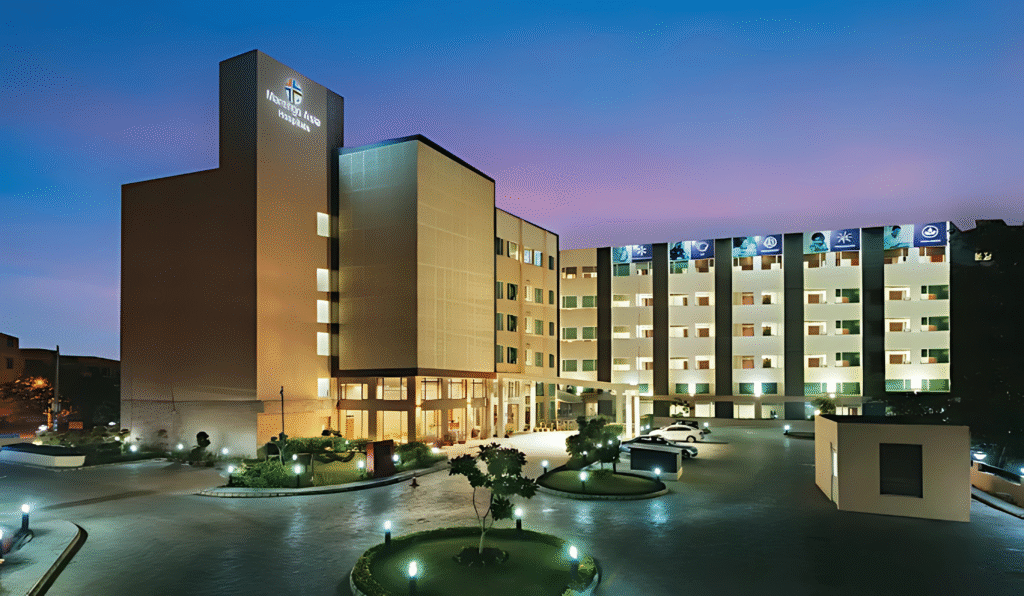Bladder Cancer Treatment Cost in India

What is Bladder Cancer?
Bladder cancer refers to the abnormal growth of cells within the bladder, an organ responsible for storing urine. It is one of the most common cancers of the urinary tract. The majority of bladder cancers start in the urothelial cells (the cells lining the inside of the bladder), which are responsible for producing and transporting urine. These cancers are known as urothelial carcinoma or transitional cell carcinoma.
Bladder cancer can vary in its stage and severity, ranging from early-stage cancer that is confined to the bladder lining, to advanced-stage cancer that spreads to other organs like the lymph nodes, liver, and bones. There are several types of bladder cancer, with the most common being transitional cell carcinoma, but it can also occur in other cells within the bladder, such as squamous cells or glandular cells.
Bladder cancer is more common in older adults, especially men, and smoking is considered one of the primary risk factors for developing the condition. Symptoms can vary, but the most common signs include blood in the urine (hematuria), frequent urination, painful urination, and pelvic pain.
Treatment options for bladder cancer depend on the stage of cancer and the patient’s overall health, and they typically involve surgery, chemotherapy, radiation therapy, and in some cases, immunotherapy.
How Does Bladder Cancer Develop?
Bladder cancer develops when cells in the bladder begin to grow uncontrollably and form a mass or tumor. It typically starts in the urothelial cells that line the inside of the bladder. These cells may become damaged due to various factors, leading to mutations in their DNA. When these mutations occur, the cells begin to divide abnormally, leading to the formation of cancerous cells that do not die off as healthy cells would.
The exact cause of these genetic mutations is not always clear, but several factors can increase the likelihood of developing bladder cancer, including:
Smoking: This is the most significant risk factor for bladder cancer. The chemicals in tobacco smoke are absorbed into the bloodstream, filtered by the kidneys, and passed into the bladder. These chemicals can irritate the bladder lining and cause DNA damage.
Chronic Bladder Infections or Inflammation: Long-term bladder infections or conditions that cause inflammation (like bladder stones) can increase the risk of developing bladder cancer.
Chemical Exposure: People who work in certain industries, such as dye, rubber, leather, or textile manufacturing, may be exposed to harmful chemicals that can increase their risk of bladder cancer.
Age and Gender: Bladder cancer is more common in people over 55 years old and is more prevalent in men than women.
Family History and Genetics: A family history of bladder cancer or genetic mutations (e.g., mutations in the TP53 gene) can make a person more likely to develop bladder cancer.
Certain Medications: Some chemotherapy drugs, such as cyclophosphamide, and long-term use of certain diabetes medications can also increase the risk of bladder cancer.
Radiation Exposure: Previous radiation therapy to the pelvic area, particularly for other cancers such as prostate or rectal cancer, can increase the risk of bladder cancer.
As bladder cancer develops, the cells can grow deeper into the bladder wall or even spread to nearby organs and lymph nodes, which makes the cancer more difficult to treat. However, early detection significantly improves the chances of successful treatment.
Symptoms of Bladder Cancer
Bladder cancer may not show obvious symptoms in its early stages, but as the tumor grows, noticeable signs may appear. The symptoms of bladder cancer are often similar to other urinary tract conditions, so it’s essential to seek medical advice if you experience any persistent symptoms.
1. Blood in Urine (Hematuria):
The most common and noticeable symptom of bladder cancer is blood in the urine. This can be visible (gross hematuria), where the urine appears pink, red, or brown, or microscopic, where blood is detected through a urine test but isn’t visible to the naked eye. Blood may appear intermittently and may not be painful, but its presence is a strong indicator of potential bladder cancer.
2. Frequent Urination:
People with bladder cancer may experience a frequent urge to urinate, even when the bladder isn’t full. This symptom can be mistaken for a urinary tract infection (UTI), but when persistent, it could signal bladder cancer, especially if other symptoms accompany it.
3. Painful Urination (Dysuria):
Pain or a burning sensation during urination can occur in people with bladder cancer. This discomfort may not always be constant and could occur intermittently, often making it difficult to differentiate from other bladder conditions.
4. Urinary Urgency:
Bladder cancer can cause a sudden, strong urge to urinate. This feeling of urgency can be persistent and occur even when the bladder is empty, often leading to discomfort or anxiety, especially during the day.
5. Lower Abdominal Pain or Discomfort:
As bladder cancer progresses, you may experience pain or discomfort in the lower abdomen or pelvic area. This could be a dull ache or sharp pain and may increase as the tumor grows or spreads.
6. Fatigue:
Bladder cancer can lead to unexplained fatigue or a general feeling of being unwell. The body’s response to cancer and the associated blood loss can cause a feeling of weakness and lethargy.
7. Unexplained Weight Loss:
Weight loss without an obvious cause can be a sign of bladder cancer, especially if it occurs in combination with other symptoms like blood in the urine and fatigue. This can be attributed to the body’s response to the cancer or the loss of nutrients.
8. Bone Pain (Advanced Stages):
In more advanced stages, bladder cancer may spread to other parts of the body, including the bones. Bone pain, especially in the lower back or pelvis, may indicate the cancer has spread beyond the bladder.
9. Swelling in the Legs or Feet (Advanced Stages):
If bladder cancer spreads to the lymph nodes or other organs, it may cause swelling in the legs, feet, or abdomen. This is typically a sign of metastatic cancer and requires immediate medical attention.
When to See a Doctor:
If you experience any of the above symptoms, particularly blood in the urine, it’s important to consult a doctor as soon as possible. While other, less severe conditions can cause these symptoms, they should not be ignored, as early detection of bladder cancer improves treatment outcomes.
Types of Bladder Cancer
Bladder cancer can be categorized into different types based on the cells where the cancer begins. The type of bladder cancer determines the treatment approach and the prognosis. There are three main types of bladder cancer, each with distinct characteristics.
Description: Urothelial carcinoma is the most common type of bladder cancer, accounting for about 90% of all cases. It originates from the urothelial cells that line the inside of the bladder.
Characteristics: This type of cancer can develop anywhere in the urinary tract, including the bladder, kidneys, ureters, and urethra. It typically forms as a tumor that can spread to nearby tissues.
Prognosis: Early detection of urothelial carcinoma generally offers a good prognosis, especially when the cancer is superficial and has not spread to deeper tissues.
Description: Squamous cell carcinoma makes up about 5-10% of bladder cancers. It begins in the squamous cells of the bladder lining, often due to chronic irritation or inflammation, such as from infections or prolonged catheter use.
Characteristics: This cancer type can be aggressive and is often more invasive than urothelial carcinoma. It may cause symptoms like difficulty urinating, pain, and hematuria (blood in urine).
Prognosis: Squamous cell carcinoma can be more challenging to treat and has a lower survival rate compared to urothelial carcinoma.
Description: Adenocarcinoma is a rare form of bladder cancer, accounting for less than 2% of cases. It starts in the glandular cells that produce mucus and fluids.
Characteristics: Adenocarcinoma is often associated with chronic bladder irritation, and it can be more aggressive, spreading quickly into nearby tissues.
Prognosis: Due to its rarity and tendency to be diagnosed at a later stage, adenocarcinoma often has a more challenging prognosis and requires intensive treatment options.
Which Type of Bladder Cancer is the Most Dangerous?
Among the various types of bladder cancer, adenocarcinoma and squamous cell carcinoma are considered the most aggressive and difficult to treat.
1. Adenocarcinoma
Description: Although rare, adenocarcinoma of the bladder is known for its aggressive nature. It originates in the glandular cells that line the bladder and produces mucus.
Reason for Danger: This type of bladder cancer is often diagnosed at an advanced stage because its symptoms are subtle and can easily be confused with other bladder conditions. Due to its rapid growth and tendency to spread, it is difficult to treat and has a lower survival rate compared to other types.
2. Squamous Cell Carcinoma
Description: Squamous cell carcinoma is more common in areas with chronic bladder irritation, such as those with a long history of urinary tract infections or catheter use. It develops in the squamous cells of the bladder lining.
Reason for Danger: This type of cancer tends to be more invasive and aggressive than urothelial carcinoma. It has a higher chance of spreading to surrounding tissues and organs, making it more challenging to treat effectively. Its symptoms are often severe, and it can lead to complications like obstructed urine flow.
Why Choose India for Treatment of Bladder Cancer
India has become a global hub for high-quality medical treatment, including bladder cancer care, offering world-class facilities, advanced technologies, and highly skilled medical professionals. Here are some reasons why India is an excellent choice for bladder cancer treatment:
India boasts state-of-the-art hospitals and medical centers equipped with the latest diagnostic and treatment technologies for bladder cancer. These hospitals follow international standards of care, ensuring that patients receive the best possible treatment.
Leading oncologists in India specialize in bladder cancer and have vast experience in treating both common and rare forms of bladder cancer. Many Indian doctors have trained abroad and are known for their expertise in advanced surgical procedures and treatments.
One of the main reasons people choose India for medical treatment is the affordability. Treatment costs in India are significantly lower than in many Western countries, including the USA, UK, and Europe, without compromising the quality of care. This allows patients to receive advanced treatments like surgery, chemotherapy, and immunotherapy at a fraction of the cost.
Indian hospitals offer the latest treatments for prostate cancer, including:
Robotic-Assisted Surgery for precise tumor removal
High-Intensity Focused Ultrasound (HIFU) for non-invasive treatment
Proton Therapy for targeted radiation with minimal side effects
Advanced Hormone & Immunotherapy Treatments
Many hospitals in India are also pioneering research in prostate cancer, offering patients personalized treatment plans based on genetic profiling and advanced molecular testing.
Indian hospitals are equipped with the latest medical technologies, including robotic surgery, targeted therapy, and state-of-the-art diagnostic equipment. These advancements help in providing the most effective and precise treatments for bladder cancer patients.
India is a global leader in medical tourism, offering:
✔ Dedicated international patient coordinators
✔ Medical visa assistance for easy travel
✔ Affordable accommodation & travel support
✔ Multilingual staff, including English-speaking doctors
This ensures a smooth and hassle-free experience for foreign patients traveling to India for treatment.
Many hospitals in India have excellent success rates for bladder cancer treatment. With highly experienced teams, cutting-edge treatments, and personalized care, patients experience favorable outcomes that are in line with international success rates.
Bladder cancer treatment in India involves a multidisciplinary approach, where teams of oncologists, urologists, radiologists, and pathologists collaborate to develop a personalized treatment plan for the patient. This ensures that all aspects of the cancer are addressed in the most effective manner.
Unlike many Western countries, where patients sometimes have to wait months for a diagnosis or treatment, Indian hospitals provide prompt care with minimal waiting times. Patients can start their treatment quickly, which is critical for cancer care.
Different types of Bladder Cancer Treatment in India
Bladder cancer treatment depends on the type, stage, and location of the cancer. In India, various advanced treatment options are available to ensure the best outcomes for patients. These treatments are personalized according to the patient’s condition and are aimed at eradicating cancer or preventing its recurrence.
How it works: Surgery is the most common treatment for bladder cancer and involves removing the tumor, part of the bladder, or the entire bladder depending on the severity of the disease.
When it’s used: Surgery is used when the cancer is confined to the bladder or when other treatments fail to control the disease. It is typically recommended for early-stage bladder cancer or for patients who are otherwise in good health.
Benefits: Surgical treatment can potentially offer a complete cure, especially when the cancer is localized. It can also provide relief from symptoms such as frequent urination or hematuria (blood in urine).
Recovery: Recovery varies depending on the extent of the surgery but typically involves a hospital stay followed by rehabilitation and adaptation to changes in urinary function.
How it works: Chemotherapy involves the use of drugs that kill cancer cells or stop their growth. The drugs are typically administered through the bloodstream, reaching cancer cells throughout the body.
When it’s used: Chemotherapy is used for advanced bladder cancer, particularly when the cancer has spread beyond the bladder. It can also be used after surgery to kill any remaining cancer cells.
Benefits: Chemotherapy can shrink tumors, manage symptoms, and improve the quality of life. It is particularly effective for bladder cancer that has metastasized or is at high risk of recurrence.
Recovery: Side effects include fatigue, nausea, hair loss, and low blood counts, but these side effects are usually temporary and subside after treatment.
How it works: Immunotherapy helps the body’s immune system recognize and fight cancer cells. Drugs like checkpoint inhibitors or Bacillus Calmette-Guerin (BCG) are commonly used to boost the immune system’s ability to target and destroy cancer cells.
When it’s used: Immunotherapy is typically used when the cancer is in advanced stages or has recurred after surgery. It can also be an option for patients who cannot undergo surgery.
Benefits: Immunotherapy can be effective in preventing cancer recurrence and improving survival rates. It has fewer side effects than chemotherapy and can sometimes offer long-term remission.
Recovery: Side effects may include fatigue, flu-like symptoms, and rashes, but these are usually less severe than traditional chemotherapy.
How it works: Radiation therapy uses high-energy rays to target and kill cancer cells. It is often used as a supplementary treatment alongside surgery or chemotherapy to treat bladder cancer.
When it’s used: Radiation is typically used for patients who are not candidates for surgery, or when surgery alone may not be sufficient. It may also be used after surgery to eliminate remaining cancer cells.
Benefits: Radiation therapy can help control symptoms of advanced bladder cancer, reduce tumor size, and prevent cancer recurrence. It is a non-invasive treatment option.
Recovery: The side effects of radiation therapy can include fatigue, skin irritation, and urinary problems, but these usually improve after treatment ends.
How it works: Intravesical therapy involves placing a chemotherapy or immunotherapy drug directly into the bladder through a catheter. The drugs stay in the bladder and target cancer cells in the bladder lining.
When it’s used: This treatment is typically used for non-muscle invasive bladder cancer or for patients who have superficial tumors.
Benefits: Intravesical therapy targets cancer cells directly, minimizing systemic side effects. It is highly effective for preventing the recurrence of bladder cancer in early-stage patients.
Recovery: Patients typically experience mild side effects such as irritation or discomfort during urination, but overall recovery is quick.
Different Procedures for Bladder Cancer Treatment in India
Bladder cancer procedures aim to remove tumors, restore bladder function, and monitor for recurrence. In India, a variety of advanced surgical techniques are used to improve the success rates of bladder cancer treatment.
How it works: Cystectomy involves the surgical removal of the bladder, either partially or completely, depending on the extent of the cancer.
When it’s used: This procedure is used for muscle-invasive bladder cancer that has not responded to other treatments. It is often recommended when the cancer is widespread in the bladder or recurring.
Benefits: Cystectomy can provide a complete cure in many cases, particularly for muscle-invasive bladder cancer, and eliminates cancer cells from the bladder area.
Recovery: Post-surgery recovery includes adjusting to a new method of urine collection, either through a urostomy or a neobladder, along with managing surgical wounds.
How it works: TURBT is a minimally invasive procedure used to remove tumors from the bladder using a resectoscope inserted through the urethra.
When it’s used: This procedure is commonly used for superficial bladder cancer or to diagnose and stage bladder cancer. It may also be used to remove smaller tumors before more extensive surgery is considered.
Benefits: TURBT is less invasive and has a shorter recovery time compared to cystectomy. It allows for precise removal of tumors while preserving the bladder.
Recovery: The recovery from TURBT is generally quick, with patients usually able to resume normal activities within a week, although some may experience temporary urinary discomfort.
How it works: This minimally invasive surgery uses robotic assistance to remove the bladder. The surgeon uses robotic arms to perform the procedure with high precision through small incisions.
When it’s used: Robotic-assisted cystectomy is used for patients with muscle-invasive bladder cancer who are candidates for a bladder removal surgery but prefer a minimally invasive approach.
Benefits: This procedure has the advantages of smaller incisions, less blood loss, and quicker recovery compared to traditional open surgery.
Recovery: Patients typically experience a shorter hospital stay and faster recovery time than with traditional cystectomy, though full recovery can take several weeks.
How it works: Blue Light Cystoscopy uses a special light to highlight cancerous cells in the bladder that are not visible under normal white light. This technology improves the accuracy of tumor detection and removal.
When it’s used: It is used during TURBT or other cystoscopic procedures to better identify tumors, especially in difficult-to-visualize areas of the bladder.
Benefits: This technique enhances the surgeon’s ability to identify and remove all cancer cells, reducing the chance of recurrence and improving outcomes.
Recovery: Recovery from Blue Light Cystoscopy is typically quick, with minimal discomfort and a fast return to normal activities.
How it works: Bladder reconstruction involves creating a new bladder (neobladder) from a piece of the intestine or other tissue after the bladder has been removed.
When it’s used: This procedure is used after cystectomy when bladder removal is necessary but the patient wants to retain normal urinary function.
Benefits: Bladder reconstruction allows for more normal urinary function, reducing the need for an external urostomy bag.
Recovery: Recovery involves an adaptation period where patients learn how to manage the new bladder. It may take several weeks or months to adjust to the reconstructed bladder.
Cost of Bladder Cancer Treatment in India
India offers world-class cancer treatment at significantly lower prices than in many Western countries. Below is a breakdown of the average cost ranges for bladder cancer treatments and procedures:
| Treatment / Procedure | Estimated Cost (INR) | Estimated Cost (USD) |
|---|---|---|
| Initial Consultation & Diagnosis | ₹5,000 – ₹10,000 | $60 – $120 |
| TURBT Surgery | ₹70,000 – ₹1,50,000 | $850 – $1,800 |
| Cystectomy (Partial / Radical) | ₹2,50,000 – ₹5,00,000 | $3,000 – $6,000 |
| Robotic-Assisted Cystectomy | ₹4,00,000 – ₹8,00,000 | $4,800 – $9,500 |
| Bladder Reconstruction (Neobladder) | ₹3,00,000 – ₹6,00,000 | $3,600 – $7,200 |
| Chemotherapy (per cycle) | ₹25,000 – ₹60,000 | $300 – $720 |
| Radiation Therapy (full course) | ₹1,50,000 – ₹3,00,000 | $1,800 – $3,600 |
| Intravesical BCG Therapy (per dose) | ₹6,000 – ₹10,000 | $70 – $120 |
| Immunotherapy (Checkpoint Inhibitors) | ₹1,50,000 – ₹3,50,000/dose | $1,800 – $4,200/dose |
| Blue Light Cystoscopy (HAL) | ₹30,000 – ₹60,000 | $360 – $720 |
| Targeted Therapy (e.g., Erdafitinib) | ₹1,00,000 – ₹3,00,000/month | $1,200 – $3,600/month |
Cost-Saving Advantage in India
In comparison to countries like the USA, UK, or Australia, treatment in India is up to 60–80% more affordable, making it a preferred destination for medical tourism. Most hospitals also offer complete packages that include diagnostics, surgery, hospital stay, medications, and follow-up care, further reducing the financial burden.
Best Doctors for Bladder Cancer Treatment in India
Best Hospitals for Bladder Cancer Treatment in India
Med Travel India Offerings
How does Med Travel India help you?
Services offered by Med Travel India

Seamless Planning for Your Medical Journey
Before you even arrive, we take care of all the groundwork. From connecting you with top specialists to ensuring all necessary medical evaluations are completed, we make your journey stress-free. Our goal is to provide clarity and comfort before your treatment begins.
- Free Medical Consultation
- Personalized Treatment Plan
- Estimated Cost & Duration
- Visa Assistanc
- Second Opinion Service
- Pre-Arrival Coordination
Worry-Free Travel & Comfortable Stay
We ensure that your journey to India is as smooth as possible. From booking your flights to arranging a comfortable stay near your hospital, we handle everything so you can focus on your health.
- Flight Booking Assistance
- Accommodation Booking
- Airport Pickup & Drop
- Language Interpretation Services
- Local Transport Arrangements
- Currency Exchange Support


World-Class Medical Care, Personalized for You
We ensure that your medical treatment is well-organized and efficient. Our team works closely with hospitals to facilitate smooth admissions, consultations, and procedures, ensuring you receive top-quality healthcare.
- Priority Appointment Scheduling
- Direct Hospital Admission
- Specialist Doctor Assignment
- Pharmacy & Medical Supplies
- Hospital Admission & Discharge Support
- 24/7 Customer Assistance
Continued Support for a Speedy Recovery
Your health journey doesn’t end after treatment. We provide post-procedure assistance to ensure a smooth recovery, whether you stay in India for rehabilitation or return home.
- Post-Surgical Care Coordination
- Rehabilitation & Physiotherapy
- Virtual Doctor Consultations
- Diet & Lifestyle Guidance
- Extended Stay Arrangements
- Post-treatment Medical Supplies


Beyond Healthcare, A Comfortable Experience
We offer additional services to make your stay in India comfortable and enriching, ensuring that your well-being is cared for beyond the hospital.
- Medical Insurance Settlement Help
- SIm Card Assistance
- Customized Sightseeing Tours
- Medical Document Assistance
- Personalized Assistance for Family Members
- Concierge Services








































